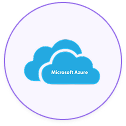Home » Cloud Migrations (AWS, Azure, GCP)
Cloud Migrations (AWS, Azure, GCP)
Migrating to the cloud offers transformative benefits for organizations of all sizes. Done right, it enables scalability on demand, reduces infrastructure costs, and enhances business agility—helping companies innovate faster and respond to market changes more effectively.
However, without a clear migration strategy, cloud adoption can quickly become a costly and complex detour. Common issues include poorly scoped workloads, unexpected expenses, performance bottlenecks, and misaligned cloud architecture.
This guide is designed to walk you through a step-by-step cloud migration journey, helping you make informed decisions whether you’re moving to AWS, Microsoft Azure, or Google Cloud Platform (GCP).
Why
Why Cloud Migration?
Reduce Infrastructure Costs
Improve System Scalability and Performance
Boost Business Continuity and Disaster Recovery
Enhance Collaboration and Remote Access
Support Innovation with AI/ML and Data Analytics Tools
Moving to the cloud but don’t know where to start?
This guide walks you through a smart, secure migration strategy — without downtime or
surprises.
Choosing the Right Cloud Provider

AWS
- Broadest service range
- Mature ecosystem
- Ideal for enterprises, startups, and global operations

Azure
- Seamless integration with Microsoft stack
- Strong hybrid capabilities
- Preferred by enterprises with Windows workloads

GCP
- Advanced analytics and machine learning
- Cost-effective compute/storage options
- Popular with digital-native and data-driven businesses
journey
Operational Handover & Continuous Support
Assessment
- Inventory current infrastructure, apps, and dependencies
- Evaluate cloud readiness
- Determine business goals and compliance needs
Proof of Concept (PoC)
- Test core workloads in target cloud
- Validate architecture, performance, and security
Operational Handover & Continuous Support
- Deliver updated architecture diagrams, migration records, and DNS cutover documentation.
- Train internal teams on post-migration monitoring and cloud platform usage.
- Set up alerting and cost tracking tools.
- Establish cloud support SLAs and escalation workflows.
- Offer periodic reviews for performance and usage optimization.
Planning
- Choose migration strategy: Rehost, Replatform, Refactor, Replace, Retire
- Define scope, timeline, and success metrics
- Estimate total cost of ownership (TCO)
Optimization and Post-Migration
- Right-size resources
- Implement cost governance
- Strengthen security and compliance
- Enable monitoring and automation
Skipping assessment or relying on assumptions
Underestimating dependencies and integration complexity
Overlooking security and compliance gaps
Lacking a rollback or contingency plan
Poor stakeholder alignment or unclear ownership
Inadequate testing before full rollout
Common Migration Pitfalls
Company Size

Small
(1-50 employees)

Mid-size
(51-500)

Large
(500+)
Estimated Effort
Notes
4-6 weeks
Simpler infrastructure,may rely on lift-andshift
2-4 months
May include replatforming and process change
6-12 months+
Complex hybrid architecture, regulatory needs
Common Migration Pitfalls
cloud migration


Cloud
readiness assessment



